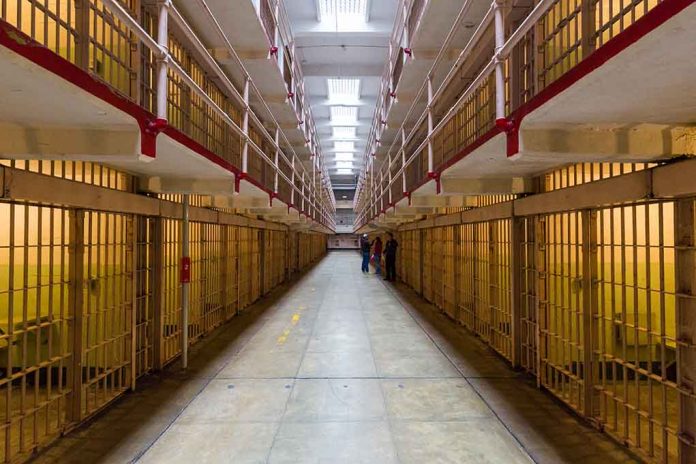
New York’s prison system plunges into chaos as guards strike and the National Guard intervenes.
Key Takeaways
- Governor Kathy Hochul has deployed the National Guard to fill positions in New York state prisons due to striking corrections officers.
- Corrections officers are striking over work environment and safety concerns, particularly related to the HALT Act.
- The strikes have been declared illegal, with participants facing pay deductions and a temporary restraining order.
- National Guard members are tasked with maintaining order, distributing meals, and medication in prisons.
- Union representatives are in negotiations with the governor’s office to resolve the situation.
Crisis Unfolds in New York’s Correctional Facilities
New York’s correctional system is facing unprecedented turmoil as prison guards continue their strike. The walkout, which began over concerns about work environment and safety, has prompted Governor Kathy Hochul to take drastic measures. In a bold move, she has declared a statewide disaster emergency and activated the National Guard to maintain order within the prisons.
The strikes have spread to nearly all of New York’s 42 prisons, including facilities in the Mohawk Valley such as Marcy, Mid-State, and Mohawk. Corrections officers are demanding better pay, increased visitor searches, and a reversal of reforms that limit solitary confinement. These demands stem from their concerns about the implementation of the HALT Act, which they argue has compromised safety and order within the prisons.
Gov. Kathy Hochul has activated the New York National Guard amid an ongoing strike at state prisons.
"These disruptive and unsanctioned work stoppages by some corrections officers must end."https://t.co/Xn3301MQbq
— 13WHAM (@13WHAM) February 19, 2025
Governor’s Response and Legal Implications
Governor Hochul has taken a firm stance against the strikes, declaring them illegal and issuing a clear directive to the participants. In a statement, she asserted, “I am directing everyone involved in these unlawful strikes to stop these actions immediately. Legal action has already commenced to ensure compliance.” This strong response underscores the gravity of the situation and the potential consequences for striking officers.
A temporary restraining order has been granted under the Taylor Law, mandating striking officers to cease their illegal activities. Non-compliance could result in fines or other sanctions. The New York State Department of Corrections has also issued a memorandum addressing workforce restoration and has suspended certain elements of the HALT Act and staffing reductions in an attempt to address some of the strikers’ concerns.
National Guard Deployment and Challenges
The deployment of the National Guard to correctional facilities marks a significant escalation in the state’s response to the crisis. Guard members have arrived at various institutions, including Bare Hill Correctional Facility and the infamous Attica Correctional Facility. Their primary tasks include distributing meals and medication, as well as maintaining general order within the prisons.
However, reports suggest that some National Guard members have retreated from unsafe conditions in the prisons, highlighting the complex and potentially dangerous nature of the situation. A significant emergency response was reported at Riverview Correctional Facility, indicating potential unrest and the challenges faced by those attempting to maintain order.
Negotiations and Path Forward
As the crisis continues, union representatives have been engaged in ongoing negotiations with the governor’s office to find a resolution. James Miller, spokesperson for the New York State Correctional Officers & Police Benevolent Association, stated, “Negotiations with the State have continued throughout today between NYSCOPBA and the Governor’s Office towards a resolution.” This dialogue offers a glimmer of hope for a peaceful end to the standoff.
The core of the dispute lies in the implementation of the HALT Act, which restricts the use of solitary confinement and promotes alternative therapeutic and rehabilitative measures. While designed to improve conditions for inmates, corrections officers argue that it has undermined their ability to maintain discipline and safety within the prisons.
As New York grapples with this unprecedented crisis in its correctional system, the outcome of these negotiations will be crucial in determining the future of prison management and the working conditions of corrections officers in the state. The deployment of the National Guard serves as a temporary measure, but a long-term solution will require addressing the fundamental concerns raised by those on the front lines of the state’s prisons.
Sources:
Chaos as guards WALK OUT of prisons leaving military to swoop in on Black Hawks
National Guard Activated Over N.Y. Prison Guard Strike







